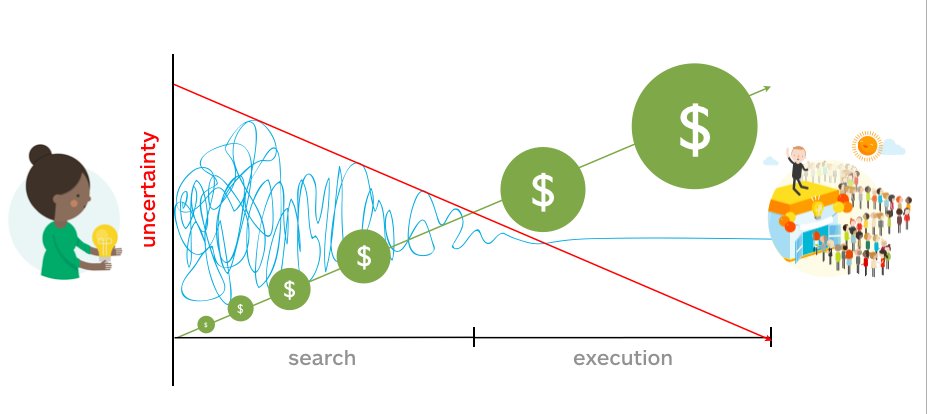File under org design. I'm now in my 18th year working in a space that has evolved from custom development to enterprise CMS/eCom, to the hyper fast moving world that's illustrated by the annually updated Martech Landscape graphic. Many (most?) organization leaders struggle to make sense of this space, to execute on the visionary use cases that they hear about at conferences, and to report a meaningful ROI on those efforts. We can attribute a lot of that struggle to the general confusion associated with the technobabble and chaotic pace of the space. But, that's not going to change anytime soon.
A spot on Tweet from Alex Osterwalder about giving yourself permission to get your ideas out in the wild as soon as possible!
Another root cause of organizational struggles can be tied to how the organizations approach innovation. Anyone that's been involved with customer experience/context marketing knows that a lot of new thinking happens and new ideas emerge during the creation process. Innovation is born out of new ideas, risk taking, failure and a general culture of curiosity. That's often times at odds with the slow change, buttoned down, risk averse culture that still resides within a lot of organizations that are many decades or centuries old.
So, how does an organization evolve to where ideation is part of the culture? There are a lot of new ways of thinking, of aligning teams, of holding meetings, etc. What I'm talking about today is how to think about innovation from a process point of view; with some financial (P&L) considerations along the way.
Purpose & program
A required precondition of ideation is organizational purpose and some sense of a program (a combination of people, processes and technology). For a dive into this, start with this post by Aaron Dignan or this Ted Talk by Simon Sinek.
T3
T3 is a 3 (ok, 4) stage rubric on how to build an organizational structure for innovation. It starts with process step T.0. T, because you need to pass a test of sorts to get past this level. And, 0, because at this stage you really don't have anything yet.
T.0 - Ideation
T.0 is all about collecting ideas from the organization. What new ideas are out there for how to deliver more (engagement) value to the customer. The ideation stage is about collecting, cataloging, defining and ranking ideas. You want to make it as easy as possible for anyone to bring new ideas to the table - no friction.
- Ideation should be billed against a general R&D budget, not assigned to any initiative.
- The R&D budget allocation should align w/ the organization's commitment to innovation. Don't say you innovate unless you back it up and budget for it.
Test points
- Does the idea align with the purpose and program?
- Do we have a champion for the idea?
- Do we have target outcomes and a rough model for how to get there? Back of the napkin math is ok at this stage.
If yes, proceed to T.1
T.1 - Hypothesis
This is the proof of concept / minimum viable product (MVP) stage. The idea becomes the product. The product needs to be both small enough to prototype quickly and large enough to matter. There's some art involved in constructing the MVP. The Hypothesis stage should also be time boxed. The Hypothesis stage should be skinny; designed to fail fast or advance to the next stage.
- Just like Ideation, the Hypothesis stage should be billed against an R&D budget. We don't want Hypothesis costs assigned to projects that make it out of the Hypothesis stage. We don't want the initiative starting in a hole.
- The costs of Hypothesis should be offset with cheap learns that will have an ROI on risk mitigation / cost reduction of the Operational project.
Test points
We need:
- Data backed outcome indicators
- Customer interest / adoption
- Executive champion(s)
- A roadmap outline (how we see this product maturing within our roadmap)
If we have these, proceed to T.2
T.2 - Operational
Advancing to the Operational stage means we have a real project on our hands. We're out of R&D mode and may be facing the challenge of a phase 1. Resist the temptation to build everything into this phase. A steady schedule of smaller builds often produces better results.
Test points
We should have a full battery of success metrics and the conversions that affect them.
We should be organizationally 'all-in'. The project should be fully resourced, with both $$ and talent.
T.3 - Scale
What a program looks like over time (net gains are the orange shaded areas)
Investment (support) doesn't end after the Operational stage. It's important to keep building on the model; to continually sharpen the saw.
- Encourage leadership to establish quantifiable value points - driving to what success looks like. Consider:
- Internal efficiencies enjoyed
- Customer lifetime value… tied to new business and/or influence on churn reduction
- Industry innovation & competitor differentiation. The laggards are more likely to lose customers, lose key employees, become more of a commodity in the eyes of the industry, become less relevant overall.
- Make sure financial models have enough soft attribution and room to recognize and foster growth elements. It's so much harder & riskier to innovate. It's also so much more rewarding and important.
- Like a fire, innovation needs air to breathe, especially if it wants to grow.
- A tight CFO that wants to apply full cost and see short term ROI can kill initiatives before they get strong enough to stand on their own. If you're faced with the tight CFO, ask them to recommend a better use of the org's resources.




